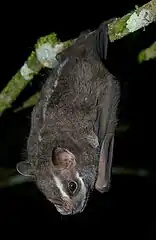| Chiroderma | |||
| W. Peters, 1860[1] | |||
 Przedstawiciel rodzaju – wielkook białopręgi (Ch. salvini) | |||
| Systematyka | |||
| Domena | |||
|---|---|---|---|
| Królestwo | |||
| Typ | |||
| Podtyp | |||
| Gromada | |||
| Podgromada | |||
| Infragromada | |||
| Rząd | |||
| Podrząd | |||
| Nadrodzina | |||
| Rodzina | |||
| Podrodzina | |||
| Plemię | |||
| Rodzaj |
wielkook | ||
| Typ nomenklatoryczny | |||
|
Chiroderma villosum W. Peters, 1860 | |||
| Synonimy | |||
|
| |||
| Gatunki | |||
| |||
Wielkook[4] (Chiroderma) – rodzaj ssaków z podrodziny owocnikowców (Stenodermatinae) w obrębie rodziny liścionosowatych (Phyllostomidae).
Zasięg występowania
Rodzaj obejmuje gatunki występujące w Ameryce Środkowej i Południowej[5][6][7].
Morfologia
Długość ciała 50–89 mm, długość ucha 11–21,5 mm, długość tylnej stopy 8–17 mm, długość przedramienia 34,9–58,4 mm; masa ciała 11–45 g[6][8].
Systematyka
Rodzaj zdefiniował w 1860 roku niemiecki zoolog Wilhelm Peters w artykule poświęconym nowemu rodzajowi nietoperzy z Brazylii opublikowanym na łamach Monatsberichte der Königlichen Preussische Akademie des Wissenschaften zu Berlin[1]. Na gatunek typowy Peters wyznaczył (oznaczenie monotypowe) wielkooka owłosionego (Ch. villosum).
Etymologia
- Chiroderma (Chirodesma): gr. χειρ kheir, χειρος kheiros ‘ręka’; δερμα derma, δερματος dermatos ‘skóra’[9].
- Mimetops: gr. μιμητης mimētēs ‘imitator, mimik’, od μιμεομαι mimeomai ‘imitować’, od μιμος mimos ‘mimik, aktor’; ωψ ōps, ωπος ōpos ‘wygląd’[10]. Gatunek typowy: Gray wymienił dwa gatunki – Chiroderma villosum W. Peters, 1860 i Chiroderma pictum J.E. Gray, 1866 – nie wyznaczając typu nomenklatorycznego.
Podział systematyczny
Do rodzaju należą następujące gatunki[11][8][5][4]:
- Chiroderma improvisum R.J. Baker & Genoways, 1976 – wielkook antylski
- Chiroderma trinitatum G.G. Goodwin, 1958 – wielkook mały
- Chiroderma gorgasi Handley, 1960
- Chiroderma salvini Dobson, 1878 – wielkook białopręgi
- Chiroderma scopaeum Handley, 1966
- Chiroderma villosum W. Peters, 1860 – wielkook owłosiony
- Chiroderma doriae O. Thomas, 1891 – wielkook brazylijski
Uwagi
- ↑ Nomen nudum.
- ↑ Niepoprawna późniejsza pisownia Chiroderma Peters, 1860.
Przypisy
- 1 2 W.C.H. Peters. Eine neue Gattung von Flederthieren, Chiroderma villosum, aus Brasilien vor. „Monatsberichte der Königlichen Preussische Akademie des Wissenschaften zu Berlin”. Aus dem Jahre 1860, s. 747, 1860. (niem.).
- ↑ J.E. Gray. Revision of the Genera of Phyllostomidæ, or Leaf-nosed Bats. „Proceedings of the Zoological Society of London”. 1866, s. 117, 1866. (ang.).
- ↑ E. Thenius: Zähne und Gebiss de Säugetiere. Berlin: De Gruyter, 1989, s. 113, seria: Handbuch der Zoologie. ISBN 978-3-11-010993-1. (niem.).
- 1 2 Nazwy zwyczajowe za: W. Cichocki, A. Ważna, J. Cichocki, E. Rajska-Jurgiel, A. Jasiński & W. Bogdanowicz: Polskie nazewnictwo ssaków świata. Warszawa: Muzeum i Instytut Zoologii PAN, 2015, s. 107–108. ISBN 978-83-88147-15-9. (pol. • ang.).
- 1 2 C.J. Burgin, D.E. Wilson, R.A. Mittermeier, A.B. Rylands, T.E. Lacher & W. Sechrest: Illustrated Checklist of the Mammals of the World. Cz. 2: Eulipotyphla to Carnivora. Barcelona: Lynx Edicions, 2020, s. 180. ISBN 978-84-16728-35-0. (ang.).
- 1 2 S. Solari, R. Medellín, B. Rodríguez-Herrera, V. da Cunha Tavares, G. Garbino, M.A. Camacho, D.T. Saá, B. Lim, J. Arroyo-Cabrales, A. Rodríguez-Durán, E. Dumont, S. Burneo, L.F. A. Urioste, M. Tschapka & D. Espinosa: Family Phyllostomidae (New World Leaf-nosed Bats). W: D.E. Wilson & R.A. Mittermeier (redaktorzy): Handbook of the Mammals of the World. Cz. 9: Bats. Barcelona: Lynx Edicions, 2019, s. 553–555. ISBN 978-84-16728-19-0. (ang.).
- ↑ D.E. Wilson & D.M. Reeder (redaktorzy): Genus Chiroderma. [w:] Mammal Species of the World. A Taxonomic and Geographic Reference (Wyd. 3) [on-line]. Johns Hopkins University Press, 2005. [dostęp 2021-02-15]. (ang.).
- 1 2 Class Mammalia. W: Lynx Nature Books: All the Mammals of the World. Barcelona: Lynx Edicions, 2023, s. 506–507. ISBN 978-84-16728-66-4. (ang.).
- ↑ Palmer 1904 ↓, s. 182.
- ↑ Palmer 1904 ↓, s. 425.
- ↑ N. Upham, C. Burgin, J. Widness, M. Becker, C. Parker, S. Liphardt, I. Rochon & D. Huckaby: Treeview of Mammalian Taxonomy Hierarchy. [w:] ASM Mammal Diversity Database (Version 1.11) [on-line]. American Society of Mammalogists. [dostęp 2023-01-15]. (ang.).
Bibliografia
- T.S. Palmer. Index Generum Mammalium: a List of the Genera and Families of Mammals. „North American Fauna”. 23, s. 1–984, 1904. (ang.).